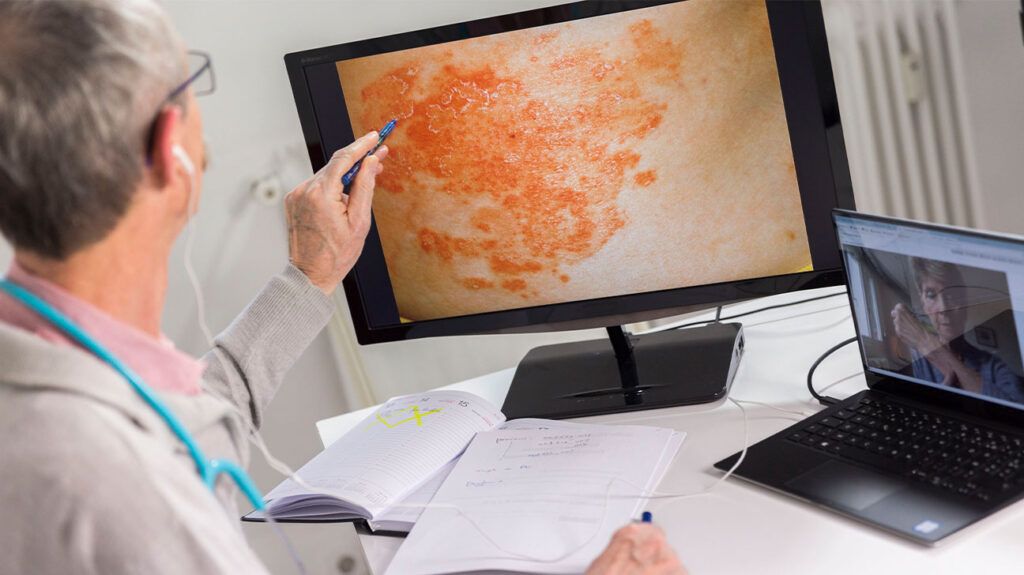
- A new study investigates gene expression in the skin tissue of people with psoriasis.
- The researchers used a relatively new technique called spatial transcriptomics.
- This approach helps map differences in gene expression in healthy and affected skin.
- The researchers said they identified immune cell changes between healthy and diseased skin.
Psoriasis is one of the most common immune-mediated inflammatory diseases, affecting up to 3% of people worldwide.
Aside from its familiar dermatological symptoms, psoriasis also affects other organs and systems.
People with the condition have an increased risk of
In addition, about 1 in 3 people with psoriasis develop psoriatic arthritis.
While scientists have made headway in understanding and treating psoriasis, it is not yet clear why there are variations in symptoms between individuals.
Some people with psoriasis have plaques on just a small part of the body while others experience them over much larger sections of skin. Also, these plaques can vary substantially in thickness, scaliness, and redness.
Evidence shows that the risk of developing
Therefore, it is vital to explore the mechanisms involved in symptom severity and how localized skin inflammation leads to systemic disease.
A recent
“Our initial goal was to find measurable molecular signals that could tell us who is more likely to develop severe psoriasis as well as who is at higher risk of developing related disorders that often accompany psoriasis, such as arthritis and cardiovascular disease,” Dr. Jose Scher, a study co-senior investigator and a specialist in psoriatic disease at NYU Langone Health in New York, said in a press statement.
Standard techniques to measure gene expression often involve homogenizing tissue samples. This means that spatial information is lost.
With spatial transcriptomics, however, scientists can analyze gene expression in intact tissue. This provides detailed information about how gene expression varies in different regions of the sample.
In the current study, this technique allowed researchers to assess immune activity in different regions and layers of skin.
In the recent study, the scientists collected tissue biopsies from the flank, forearm, or buttocks of three healthy participants as well as 11 participants with psoriasis.
In total, the researchers analyzed 25 biopsies.
The researchers reported that in more severe cases of psoriasis certain cells were in different positions within the skin’s layers.
Immune cells in samples from healthy participants were particularly prevalent around follicles and blood vessels. However, these cells were closer to the skin’s surface in samples from people with psoriasis.
In particular, fibroblasts — a key source of inflammatory cytokines — and macrophages were more common in the upper layers of skin in severe disease.
In moderate-to-severe cases of psoriasis, the researchers noted increased gene expression in molecular pathways associated with the control of lipid levels and metabolism.
These pathways play a role in various metabolic dysfunctions, including type 1 diabetes, nonalcoholic fatty liver disease, cholesterol metabolism, and lipolysis in adipocytes.
The researchers identified this uptick in expression in both psoriatic lesion tissue and unaffected tissue from participants with psoriasis. This underlines one of the challenges in studying psoriasis — even if drugs successfully treat the more obvious external physical symptoms, molecular mechanisms may still be working against overall health.
These metabolic pathways, the authors suggest, may play some part in the increased risk of diseases such as type 2 diabetes. However, researchers will need to carry out more work to understand how this plays out.
Follicles are rich with commensal bacteria. They also act as a gateway for the entry of allergens and pathogens. Follicular regions also richly express cytokines and immune activation factors.
As the authors explain, animal studies show that bacteria living in follicles are important for immune surveillance. As an immune-mediated disease, these bacteria could provide another piece of the psoriasis puzzle.
This study demonstrated how immune cells are situated more distantly from follicles in psoriatic samples, which could interrupt the healthy interaction between commensals and the immune system.
Researchers said understanding which microbes reside in follicular regions within healthy and diseased skin might provide more insight.
Researchers said this study adds an important new tool for dermatology research because spatial transcriptomics effectively defined biologically relevant, distinct cellular “neighborhoods” in healthy skin.
“Our study serves as a valuable resource for the scientific community, offering the most comprehensive archive of cellular and molecular features involved in both diseased and healthy skin,” said Shruti Naik, PhD, a study senior co-investigator and an assistant professor in the departments of pathology and medicine as well as the Ronald O. Perelman Department of Dermatology at NYU Langone, in a press statement.
Medical News Today spoke with Axel Svedbom, PhD, a researcher at the Karolinska Institutet in Sweden who was not involved in the study.
One of the challenges of studying psoriasis, he explained, is that the condition “is quite heterogenous and it is possible that grouping all patients with psoriasis together masks important mechanisms that would be found if patients were more carefully phenotyped.”
He added that techniques, such as spatial transcriptomics, might help scientists move toward this goal and build more specific treatment plans for individuals.
“I think the next step is to move toward precision medicine. Combining data from clinicians, patients, and the lab will help us to identify the right treatment for the right patient and at the right time,” Svedbom said.
As technology advances and spatial transcriptomics gains higher resolution, the study authors said they hope to gather increasingly detailed information about skin in healthy and diseased states.
“Collectively, our findings underscore the value of spatially-resolved gene profiling in understanding emergent cellular ecosystems underlying health and disease,” they wrote.
